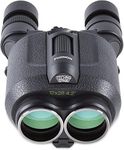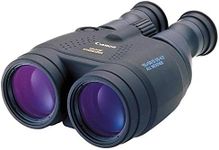Buying Guide for the Best Image Stabilized Binoculars
Choosing the right image-stabilized binoculars can greatly enhance your viewing experience, whether you're birdwatching, stargazing, or enjoying a sports event. Image-stabilized binoculars are designed to reduce the shakiness that can occur when holding binoculars by hand, providing a clearer and more stable image. To find the best fit for you, it's important to understand the key specifications and how they align with your needs.MagnificationMagnification refers to how much closer an object appears through the binoculars compared to the naked eye. This is important because higher magnification can bring distant objects into clearer view. However, higher magnification can also make the image shakier, which is where image stabilization comes in. Typically, magnifications of 8x to 10x are suitable for general use, providing a good balance between image stability and detail. For more specialized activities like astronomy, higher magnifications might be preferred, but they will require more effective stabilization.
Objective Lens DiameterThe objective lens diameter is the size of the front lenses of the binoculars, measured in millimeters. This spec is important because larger lenses can gather more light, which is beneficial in low-light conditions. For example, binoculars with a 42mm objective lens are great for general use and provide a bright image in various lighting conditions. Larger diameters, such as 50mm or more, are better for low-light activities like stargazing but can make the binoculars heavier and bulkier.
Image Stabilization TechnologyImage stabilization technology is what sets these binoculars apart from regular ones. This feature reduces the shakiness caused by hand movements, providing a steadier image. There are different types of stabilization technologies, such as electronic or mechanical. Electronic stabilization is often lighter and more compact, while mechanical stabilization can be more robust and effective. Consider how much stabilization you need based on your typical usage; for example, if you plan to use the binoculars on a moving platform like a boat, more advanced stabilization might be necessary.
Field of ViewField of view (FOV) is the width of the area you can see through the binoculars, usually measured in feet at 1,000 yards or meters at 1,000 meters. A wider field of view is important for tracking moving objects, such as birds or athletes, as it allows you to see more of the scene at once. For general use, a field of view of around 300-400 feet at 1,000 yards is typically sufficient. If you need to follow fast-moving subjects, look for binoculars with a wider field of view.
Weight and SizeThe weight and size of the binoculars can affect how comfortable they are to use, especially for extended periods. Lighter and more compact binoculars are easier to carry and hold steady, but they might have smaller objective lenses and less powerful stabilization. Heavier binoculars can offer better image quality and stabilization but may cause fatigue if used for long periods. Consider how you plan to use the binoculars and choose a weight and size that you can comfortably manage.
Durability and Weather ResistanceDurability and weather resistance are important if you plan to use your binoculars outdoors in various conditions. Look for binoculars that are waterproof and fog-proof to ensure they can withstand rain and humidity. Additionally, a rugged build can protect the binoculars from drops and bumps. If you are an avid outdoor enthusiast, prioritize these features to ensure your binoculars can handle the elements.












